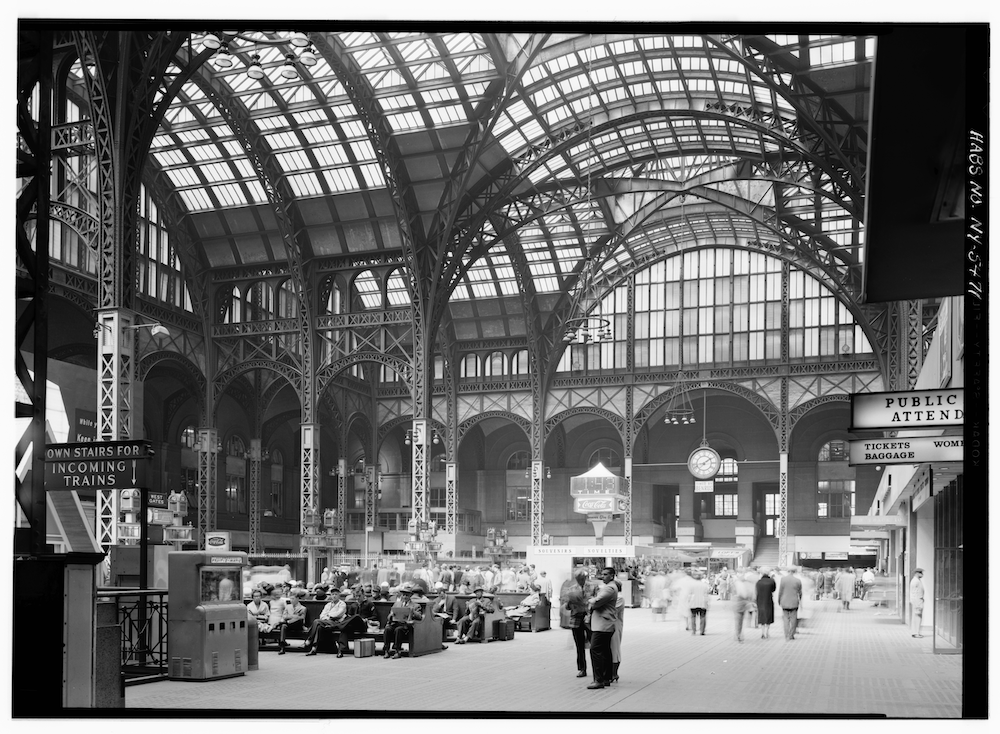On August 1, 1910, the then new Penn Station was completed, starting its path to becoming an iconic piece of New York history, and for a time, the primary way for New Yorkers to make their way out into the rest of America and back home again. In fact, in 1945, 100 million passengers passed through Penn Station.
Sadly, just over 50 years later, the great building started to be torn down in October of 1963, nearly ten-years after the Air Rights over Penn Station were sold to build a skyscraper over the top of it. (For the full story, watch this excellent PBS documentary The Rise and Fall of Penn Station here or read the excellent Conquering Gotham, about the construction of the building.)
The results, 1 Penn Plaza, and the present Madison Square Garden, may have been seen as an improvement to many at the time. Indeed, the New York TImes started their story on first day of demolition in October 1963 with the following quote:
Pennsylvania Station, a grimy monument to an age of expansive elegance, suffered the fate of an anachronism yesterday.
– New York Times, “Demolition Starts At Penn Station; Architects Picket; Penn Station Demolition Begun; 6 Architects Call Act a ‘Shame'”, October 29, 1963
The next day, the New York Times‘ editorial team, in an op-ed said what many New Yorkers who look back on the destruction now feel.
Until the first blow fell no one was convinced that Penn Station really would be demolished or that New York would permit this monumental act of vandalism against one of the largest and finest landmarks of its age of Roman elegance.
– New York Times, “Farewell to Penn Station”, October 30, 1963
The conflict between the old and the new has raged through the history of New York – it’s been a global theme pretty much since it’s beginning. But the destruction of Penn Station marked a sea change in the urban thinking that everything old is bad, and everything new is good. To me, the loss of Penn Station is a tragedy but one that led to bigger and most lasting change.
During the 9 years between the announcement of the air rights sale and the destruction of the iconic building, the Landmarks Preservation Commission was started by New York City Mayor Robert Lindsay, to help prevent another Penn Station from happening again, and the Penn Station fiasco build the framework for Jane Jacobs’ efforts to defend iconic neighborhoods in lower Manhattan from the whims of Robert Moses’ planning pen. (Sidebar: Jane Jacobs appears in from the Marvelous Mrs. Maisel defending against Moses’ plans to allow vehicle traffic in Washington Square Park.)

My favorite photo shows life in the great building towards the end. Taken in April 1962, just over a year before the wrecking ball started its work, it takes you back to the time and place, and the expanse of what the Penn Station building was. The photographer makes you feel like you were there. To me, there is genuine beauty in this moment and it’s simplicity. It’s a reminder to me of the beauty of everyday moments, and of life itself. I get FOMO every time I see it, and it feels like a thing worth treasuring.
It’s with this in mind that I added this photo to the front page of the website, and to my new business cards, pictured above. Living in an era where media can be created at a large scale quickly, and assets can be disposable, and FOMO can happen instantly, it’s important to remember that innovation also leaves a responsibility to recognize who and what have come before. It’s important and to tell the stories of mistakes and progress, of success and failure, of the forgotten and remembered. These gestures are my small way of doing this. I encourage you to do the same with something that you love, too.

Postscript Reading list:
- Moses’ full story is told in my favorite book of all time, Robert Caro’s The Power Broker, an epic read but worth the time in understanding the impact that one man had and still has on the New York City landscape
- Jane Jacobs’ The Death and Life of Great American Cities is a must read for anyone interested in the foundations of responsible urban renewal projects.